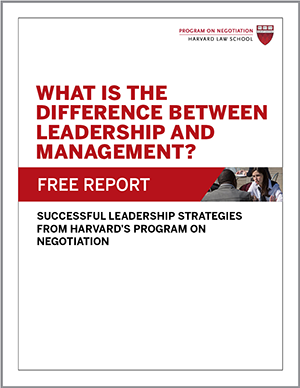
When a negotiation isn’t going well, strong leadership skills are often needed to get it back on track. Two recent news stories demonstrate that tenacious and inventive organizational leadership can help renew hope for agreement—and illustrate why negotiation is important in leadership.
Trying to bring Barneys back from the brink
For decades, luxury department store Barneys New York was the preening peacock of Madison Avenue, adored by Manhattan’s trendsetters for its embrace of outré designers and its wacky window displays. Barneys branched out in the 1980s and 1990s, opening 100 stores nationwide.
But Barneys’ organizational leadership floundered though a 1996 bankruptcy and changes in ownership and leadership while struggling to compete in an era of fast fashion, e-commerce, and soaring rents. On August 6, 2019, the company, owned by former hedge-fund manager Richard Perry, declared bankruptcy for a second time. Yet Barneys’ leaders were determined to once again rise from the ashes, write Vanessa Friedman and Sapna Maheshwari in the New York Times.
Barneys CEO Daniella Vitale met with potential buyers in the hopes of driving up the sale price at an auction. But by mid-October, the company had attracted only one serious bid, from brand-licensing firm Authentic Brands and liquidator B. Riley. Authentic planned to license the Barneys name to other companies, while B. Riley would sell off Barneys’ high-end merchandise at a discount.
Even after the bidding deadline had passed, Barneys’ lawyers scrambled to find last-minute bidders willing to preserve some of its stores and 2,300 jobs. At a suspenseful Halloween bankruptcy hearing held to authorize a sale to Authentic and B. Riley, Joshua Sussberg, a lawyer representing Barneys, asked Judge Cecelia G. Morris to give potential buyers until the next morning to make a bid that could keep “jobs and stores open, viable, available for employees, for landlords, for trade vendors,” according to the Times. The judge agreed, but no new bid appeared, and Barneys was “sold for parts” to Authentic and B. Riley, the Times reports.
The lesson for organizational leadership: After years of flawed strategic leadership, neglect, and bad luck, negotiations to right a sinking ship can be too little, too late.
Weaving a delicate web in organizational leadership
For fans of superhero movies, the news in August 2019 was heartbreaking: Disney-owned Marvel Studios would no longer be featuring the Spider-Man character in its blockbuster films after failing to renegotiate a licensing arrangement with Sony, which owns the rights to the character.
Back in 2015, Sony and Marvel inked a deal to share Spider-Man across five films. Welcoming Spider-Man, as portrayed by actor Tom Holland, to the “Marvel cinematic universe”—which is populated by the likes of Iron Man, Captain America, and Black Widow—was a blockbuster move: 2017’s Spider-Man: Homecoming earned $880 million, and 2019’s Spider-Man: Far from Home raked in $1.1 billion. Holland also appeared as Spider-Man in three of Marvel’s hit Avengers films.
Yet negotiations for a third Spidey film ground to a halt, according to Hollywood Reporter. Disney wanted a much larger share of profits than the small percentage Marvel had negotiated; Sony flatly rejected the proposed 50-50 co-financing offer. Both parties believed they’d be fine without the other.
The negotiations were “100 percent dead,” an industry source told the Hollywood Reporter, when an unlikely hero swooped in to save the day. On the talk show Jimmy Kimmel Live!, 23-year-old Holland recounted being “devastated” to learn that he’d no longer play Spider-Man. He emailed Disney chairman and CEO Bob Iger to thank him for “an amazing five years.” Iger ended up calling Holland, who was drinking at a pub with his family. Holland became “really emotional” on the call, he said, as he shared how much the Spider-Man films meant to him and to fans.
“It was clear that he cared so much,” Iger said in his own interview with Kimmel, “ . . . and that the fans wanted all this to happen.” Iger phoned Disney Studios team members and then Sony Pictures chairman Tom Rothman. “I said, ‘We’ve got to figure out a way to get this done.’”
A month later, the two studios reached a deal for Marvel to produce a third Spider-Man film for Sony, which will receive 25% of net gross and pay 25% of the film’s budget. Spider-Man will also appear in at least one other Marvel film, according to the Hollywood Reporter.
How to explain the studios’ change of heart? The many millions, even billions of dollars they stand to earn from Spider-Man films and merchandising had something to do with it. But according to Iger, there was a deeper lesson regarding organizational leadership and the role of leadership in negotiation: “Sometimes companies . . . or people, when they’re negotiating with one another, they kind of forget that there are other folks out there who actually matter.”
Have you had experiences where skilled organizational leadership saved a troubled negotiation?





